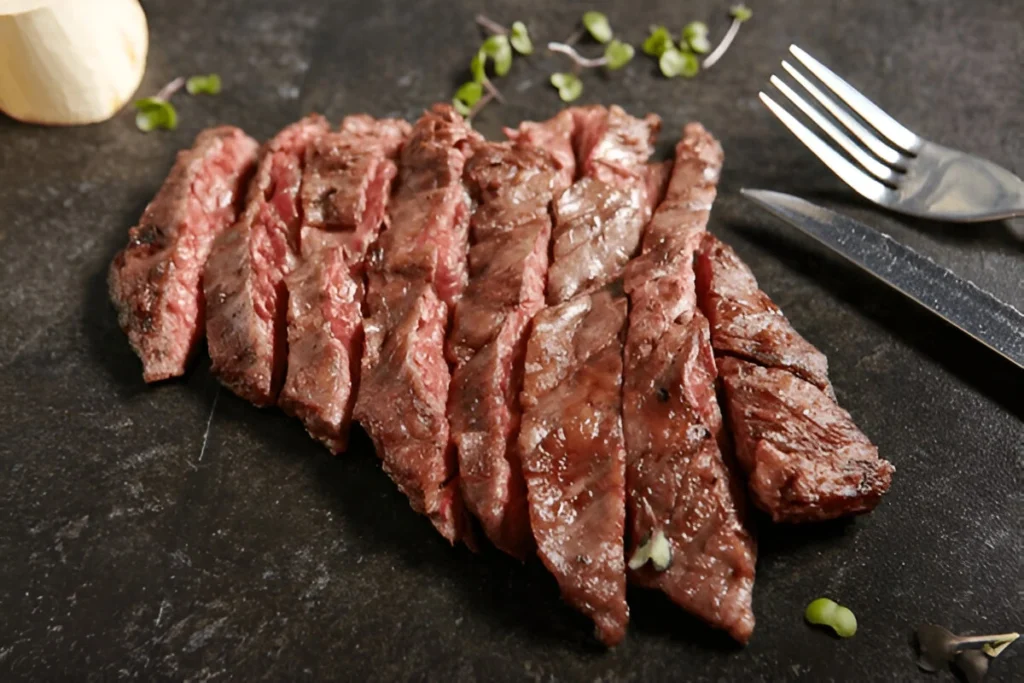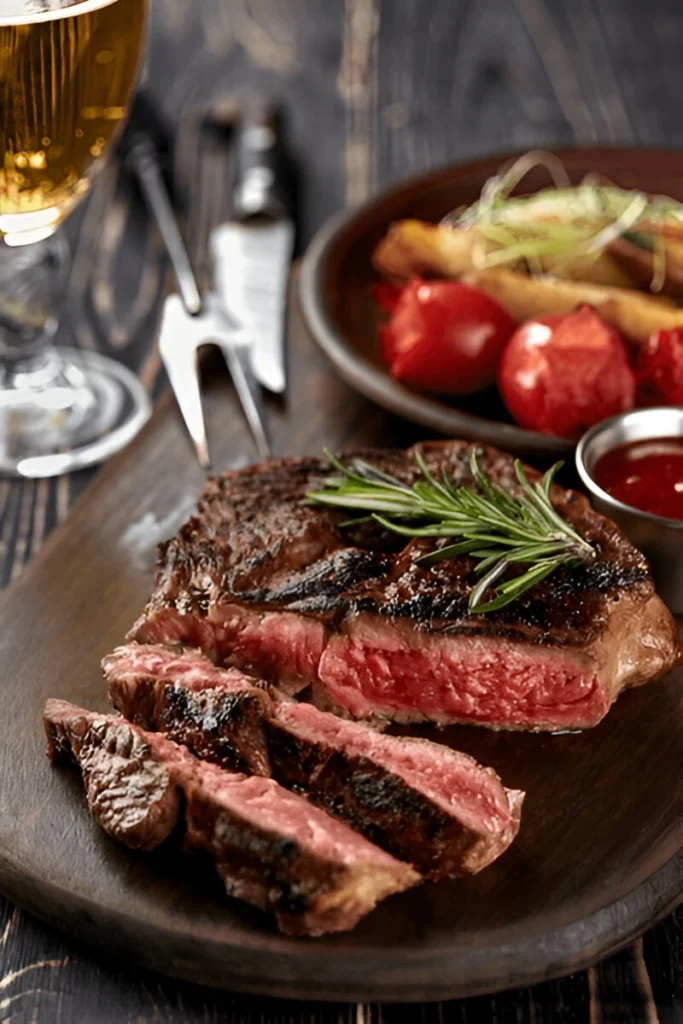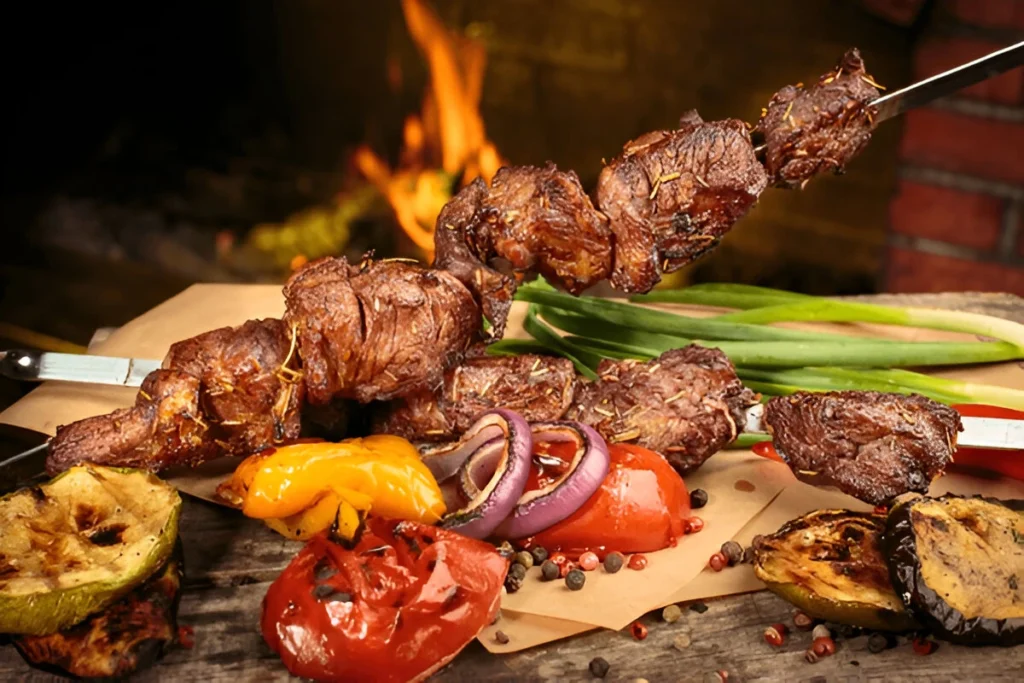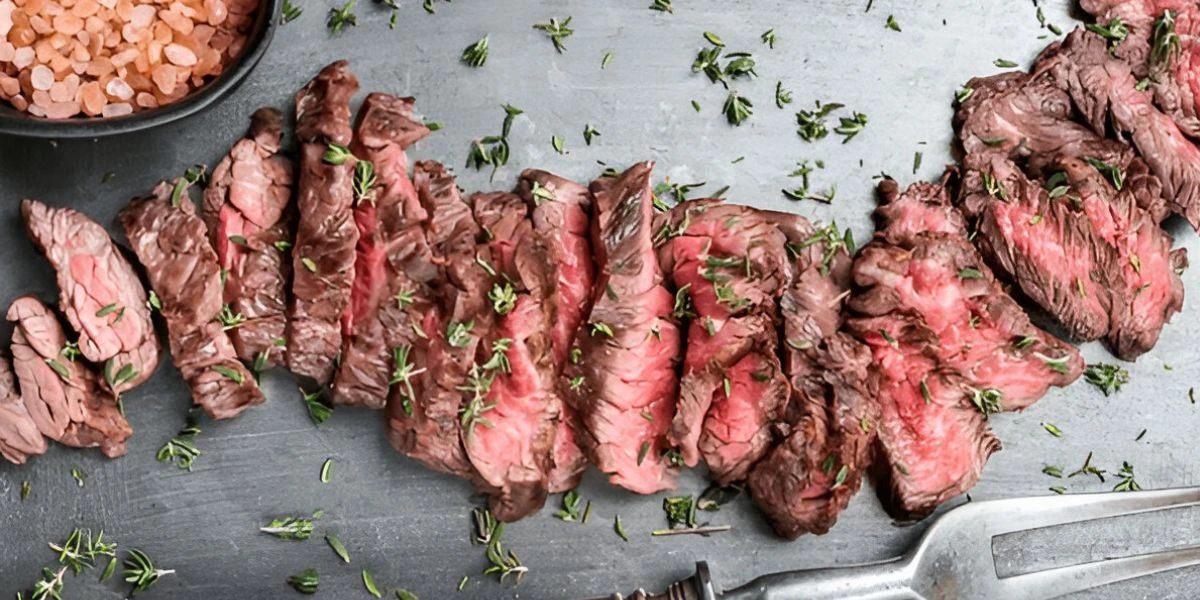Table of Contents
Skirt steak is a versatile and flavorful cut that deserves a spot in every home chef’s repertoire. This guide will give you the essential knowledge and techniques to make restaurant-quality skirt steak at home. We’ll cover everything from understanding the unique properties of this cut to mastering high-heat cooking.
Whether you’re grilling, searing, or pan-frying, the keys to unlocking skirt steak’s full potential are proper preparation, cooking methods, and timing. By the end of this guide, you’ll know how to select the best cuts, season them perfectly, and cook them to your desired doneness. This will result in tender, juicy, and flavorful skirt steak every time.
Key Takeaways
- Skirt steak is a versatile and flavorful cut that can be cooked to perfection at home.
- Understanding the unique characteristics of skirt steak, such as its texture and flavor profile, is crucial for achieving optimal results.
- Proper selection, preparation, and cooking techniques, including high-heat methods, are essential for making perfect skirt steak.
- Mastering the art of resting and slicing skirt steak can greatly enhance the overall tenderness and juiciness.
- Pairing skirt steak with the right side dishes and wines can elevate the dining experience.
Understanding What Makes Skirt Steak Special
Skirt steak is a distinctive and richly flavorful cut of beef. It offers a distinct culinary experience. This cut is loved by both home cooks and professional chefs for its texture and flavor.
Difference Between Inside and Outside Skirt
Inside and outside skirt steak have their own traits. The inside skirt is tender and juicy. The outside skirt is tougher but has a strong beefy taste.
Unique Texture and Flavor Profile
Skirt steak has a chewy texture. This comes from the muscle fibers running parallel to the meat’s grain. It’s perfect for high-heat cooking because the heat tenderizes it and brings out its flavors.
Why Skirt Steak is Perfect for High-Heat Cooking
- The thin, flat shape of skirt steak allows for quick searing and caramelization. This locks in juices and gives a delicious, charred exterior.
- Its resilient texture can handle high temperatures. It’s great for grilling, broiling, or pan-searing.
- The intense beef flavor of skirt steak comes alive with high heat. It creates a mouthwatering, umami-rich experience.
Understanding skirt steak‘s unique qualities is key. By knowing its texture, flavor, and love for high-heat cooking, you can cook it to perfection.
Essential Tools and Equipment for Perfect Results
To get the perfect skirt steak, you need the right tools and equipment. A reliable meat thermometer and top-notch grilling techniques are key. Each tool helps bring out the meat’s full flavor and tenderness.
A meat thermometer is crucial for cooking the skirt steak just right. It lets you check the meat’s internal temperature. This way, you can avoid overcooking or undercooking and get the steak to your liking. Whether you like it rare, medium-rare, or well-done, a meat thermometer is a must-have.
The cooking surface is also important. Skirt steak does best when seared at high heat. A grill or cast-iron skillet is perfect for this. The high heat seals in the juices and creates a tasty crust on the outside. Using these methods and the right grilling techniques will help you make restaurant-quality skirt steak every time.
| Essential Tool | Contribution to Perfect Skirt Steak |
| Meat Thermometer | Ensures proper internal temperature and doneness level |
| Grill or Cast-Iron Skillet | Provides the high heat needed for caramelized searing |
| Tongs or Spatula | Allows for gentle handling and flipping of the delicate steak |
With these essential tools and a bit of technique, you’ll master skirt steak perfection. Keep these tools ready, and you’ll always serve up delicious results.
Choosing the Best Quality Skirt Steak
Enjoying a delicious skirt steak starts with picking the right cut. It’s important to know about the USDA grading system and how to spot fresh meat. Let’s explore how to choose the best skirt steak for your dishes.
Grade Selection Guidelines
The USDA grading system shows beef quality. For skirt steak, look for “Choice” or “Prime” grades. These mean the meat has more marbling, which makes it taste better, feel softer, and stay juicier.
Visual Indicators of Quality
There are visual signs to spot a top-notch skirt steak. It should be bright red, have a fine grain, and little to no blemishes. Stay away from skirt steak that looks dry, dull, or too wet.
Where to Buy Premium Cuts
For the best skirt steak, buy from trusted butchers, specialty meat shops, or upscale grocery stores. These places often have top-quality beef cuts like ribeye and sirloin too. You can also try online stores that ship great beef right to you.
Choosing the finest skirt steak makes your dish truly special. Improve your cooking by picking the highest quality available.

Preparing Your Skirt Steak Before Cooking
To get the best skirt steak recipe, you need to prepare it right. First, trim off any extra fat, leaving a thin layer for flavor. Use a paper towel to dry the steak, removing any moisture. This step is key for a great sear and texture.
Then, season the steak with salt and pepper. You can also add garlic powder, onion powder, or fresh herbs for extra taste. Rub a light layer of olive oil on the steak before seasoning. This oil helps the spices stick and adds a savory flavor.
Let the seasoned steak sit at room temperature for 15-30 minutes before cooking. This helps the meat cook more evenly and tenderly.
By following these steps, you’ll make a perfectly seared and tasty skirt steak recipe every time.
The Ultimate Skirt Steak Marinade Recipe
Take your skirt steak to the next level with this easy marinade recipe. The secret to tender, flavorful steak is in the right mix of flavors and marinating. Let’s dive into the key ingredients and steps to bring out the best in this meat.
Core Marinade Ingredients
- Olive oil: The base of the marinade, adding a smooth, rich feel.
- Garlic: Whether minced or crushed, it brings a savory taste.
- Soy sauce: It adds a hint of umami and tenderizes the meat.
- Lime juice: It adds a zesty, acidic touch.
- Brown sugar: A bit of sweetness to balance the flavors.
- Spices: A mix of black pepper, rosemary, and thyme for a great aroma.
Marination Time and Temperature
For the best results, marinate your skirt steak marinade for 2 to 8 hours in the fridge. This lets the flavors soak in and the meat tenderize. Make sure to flip the steak a few times for even coverage.
Alternative Marinade Variations
While the classic skirt steak marinade is great, you can try new flavors too. Swap lime juice for balsamic vinegar or add Dijon mustard for a tangy twist. For a spicy flavor, add hot sauce or crushed red pepper flakes.
The main thing for a perfect skirt steak marinade is to let the flavors mix and the meat tenderize before cooking. With this recipe and a bit of creativity, you’ll make delicious skirt steak every time.
High-Heat Cooking Methods for Perfect Results
High-heat cooking techniques are key to perfect skirt steak. Grilling and broiling are top choices. They bring out the steak’s full flavor. Let’s dive into each method to master cooking skirt steak.
Grilling: The Sear-Sational Choice
Grilling is a classic way to cook skirt steak.It forms a flavorful crust on the outside while keeping the inside tender and juicy. To get great grill marks, control the heat and timing.
Searing: The Crust-Creating Sensation
Searing uses a very hot pan to make a golden crust on the steak. The pan must be extremely hot before adding the meat. This creates a delicious crust.
Broiling: The Controlled Intensity
Broiling is another high-heat method for skirt steak. It gives a sear similar to grilling but in a controlled space. It’s great when you can’t grill outside.
| Cooking Technique | Benefits | Challenges |
| Grilling | Infuses smoky flavor, creates grill marks | Requires careful temperature and timing management |
| Searing | Develops a flavorful crust, retains juices | Requires extremely hot pan, can be prone to overcooking |
| Broiling | Provides controlled high-heat environment | Requires close monitoring to avoid burning |
The choice of cooking method depends on your preference and what you have. Try each method to find your favorite. This way, you’ll get a perfect sear and juicy steak every time.
Mastering the Grilling Technique
To get the perfect grilled skirt steak, it’s not just about throwing the meat on the grill. You need to master the grilling technique. This involves managing the temperature and achieving those perfect grill marks. Let’s explore how to grill this flavorful cut to perfection.
Temperature Control Tips
When grilling skirt steak, controlling the temperature is key. This cut loves high heat, so keep your grill hot and steady. Here are some tips to help you:

- Preheat your grill to a high temperature of 450°F to 500°F for the best searing results.
- Keep an eye on the temperature and adjust as needed to avoid flare-ups or uneven cooking.
- Use a reliable instant-read thermometer to ensure the grill stays at the right temperature.
Timing Your Cook
Timing is everything when grilling skirt steak. This thin cut cooks fast, so watch the clock closely:
- Grill the steak for 2 to 3 minutes per side for a medium-rare doneness.
- Adjust the cooking time if you want your steak cooked differently.
- Don’t forget the resting time, as the steak’s internal temperature will rise after it’s off the grill.
Grill Mark Techniques
Getting those perfect grill marks on your grilled skirt steak shows you’re a pro griller. Here are a few tips to enhance the appearance of your dish:
| Technique | Description |
| Diagonal Grill Marks | Place the steak on the grill at a 45-degree angle and cook for 2 to 3 minutes. Rotate the steak 45 degrees and cook for another 2 to 3 minutes to create a criss-cross pattern. |
| Parallel Grill Marks | Position the steak perpendicular to the grill grates and cook for 2 to 3 minutes. Flip the steak and cook for another 2 to 3 minutes to create parallel grill marks. |
By mastering temperature control, timing, and grill mark techniques, you’ll be well on your way to serving up perfectly grilled skirt steak every time.
Understanding Steak Doneness Levels
Enjoying a perfectly cooked steak means knowing the different doneness levels. The temperature for steak inside is key to its texture and juiciness. Let’s look at the steak doneness levels and how to get your favorite.
Rare steaks have a cool, red center and are soft. For a rare steak, target an internal temperature of 125°F (52°C). Medium-rare steaks have a warm, red center and a slightly firmer texture. Aim for 130-135°F (54-57°C) for medium-rare.
As you move up, the steak’s center gets warmer and more cooked. Medium steaks have a warm, pink center and are firmer. Aim for 140-145°F (60-63°C). Medium-well steaks have a faintly pink center and a firm texture. Target 150-155°F (66-68°C).
Well-done steaks have a fully cooked, gray center and are firm and dry. For a well-done steak, aim for 160°F (71°C) or higher. Keep in mind that the steak’s temperature will keep rising as it rests. So, remove it from the heat just before it reaches your desired doneness.
| Doneness Level | Internal Temperature | Appearance and Texture |
| Rare | 125°F (52°C) | Cool, red center, soft and tender |
| Medium-Rare | 130-135°F (54-57°C) | Warm, red center, slightly firmer texture |
| Medium | 140-145°F (60-63°C) | Warm, pink center, firmer texture |
| Medium-Well | 150-155°F (66-68°C) | Slightly pink center, firm and resilient texture |
| Well-Done | 160°F (71°C) or higher | Fully cooked, gray center, firm and dry texture |
Knowing these steak doneness levels and checking the internal temperature for steak helps you get the perfect doneness. This way, you can enjoy a delicious steak every time.
The Critical Importance of Resting Your Steak
Resting your skirt steak after cooking is key, yet often missed. It greatly improves the steak’s texture and taste. When cooking, the meat’s juices move to the surface. Letting the steak rest allows these juices to spread evenly, making it juicier and tenderer.
Optimal Resting Times
The best resting time for skirt steak depends on its thickness. Generally, rest it for 5-10 minutes before slicing. This lets the juices reabsorb and the temperature stabilize.
Proper Resting Technique
To rest your skirt steak right, place it on a cutting board or plate. Cover it loosely with foil. This keeps the heat in and lets the juices spread. Don’t cut into the steak too soon, as this will lose the juices and flavor.
Understanding the need to rest your skirt steak is crucial. Follow the right resting times and methods for perfect steak doneness levels and internal temperature for steak. Remember, patience is essential for a delicious steak.
Slicing Techniques for Maximum Tenderness
Slicing your skirt steak right can make a big difference. Learning to slice skirt steak against the grain is key for tenderness. It makes your meal better.
First, understand why slicing skirt steak against the grain is important. The grain is the muscle direction. Cutting across it shortens the fibers, making the meat tender and easy to chew.
- Use a sharp, high-quality knife. A serrated or straight-edge knife is best for skirt steak.
- Slice the steak across the grain, making thin, even slices at a 45-degree angle. This creates tender, bite-sized pieces.
- Slice the steak immediately after it has rested, while it’s still warm. This keeps the juices in and makes it tender.
- Avoid a back-and-forth sawing motion, as it can damage the meat. Instead, use a smooth, single slicing motion.
- Consider the thickness of your slices. Thinner slices (about 1/4 inch thick) are more tender. Thicker slices might be better for certain cooking techniques.
By following these simple slicing techniques, you’ll get the most out of your skirt steak. You’ll enjoy a tender and flavorful meal every time.

Perfect Side Dishes and Wine Pairings
Enjoying a delicious skirt steak is even better with the right side dishes and wine. Let’s look at some classic sides that match the rich flavors of this beef cut.
Classic Side Dish Options
- Grilled or roasted vegetables, like asparagus, Brussels sprouts, or bell peppers and onions.
- Creamy mashed potatoes or crispy roasted potatoes, seasoned just right.
- A crisp salad made with mixed greens, cherry tomatoes, and a delicate vinaigrette.
- Buttery sautéed mushrooms or caramelized onions, adding sweetness.
Wine Selection Guide
For wine with skirt steak, pick a bold, full-bodied red. It should match the meat’s strong flavors. Here are some great options:
| Wine Variety | Tasting Notes | Why it Pairs Well |
| Cabernet Sauvignon | Rich, dark fruit flavors with firm tannins | The bold, tannic structure of Cabernet Sauvignon complements the robust taste of skirt steak. |
| Malbec | Ripe, jammy fruit with a smooth, velvety texture | The full-bodied nature of Malbec pairs beautifully with the juicy, flavorful skirt steak. |
| Petite Sirah | Intense, inky color with notes of black pepper and spice | The bold, spicy character of Petite Sirah complements the charred, grilled flavors of skirt steak. |
With the right side dishes and a glass of these red wines, your meal will be unforgettable.
Conclusion
In this guide, you’ve learned how to make perfect skirt steak every time. You now know how to prepare and cook it to perfection. This knowledge will help you improve your skirt steak dishes.
The secret to perfect skirt steak is using high-quality ingredients and the right tools. Marinating it with the best flavors and searing it at high heat brings out its full taste. This makes it a versatile and delicious cut of beef.
Creating the perfect skirt steak is a journey of trying new things. Experiment with marinades, seasonings, and cooking methods to find your favorite way to cook it. With the tips from this article, you’re ready to impress everyone with your skirt steak skills.
FAQ
How do inside and outside skirt steak differ?
Inside skirt steak comes from the plate, while outside skirt steak is from the diaphragm. Inside skirt is softer, with a milder taste. Outside skirt is firmer and has a richer flavor.
Why is skirt steak perfect for high-heat cooking?
Skirt steak’s texture is great for high-heat cooking like grilling and searing. High heat quickly caramelizes the outside. This keeps the inside juicy and tender.
What are the essential tools and equipment needed for cooking skirt steak?
You’ll need a meat thermometer, a hot grill or skillet, and sharp knives. These tools help you cook the steak perfectly, ensuring it’s tender and juicy.
How do I select a high-quality skirt steak?
Choose skirt steak with a bright red color and little marbling. Look for USDA Choice or Prime grades. The best cuts come from premium butchers or specialty meat markets.
What is the best way to prepare skirt steak before cooking?
Remove any excess fat and dry the steak using paper towels. Season with salt and pepper. You can also rub it with olive oil, garlic, and herbs for extra flavor.
What’s the perfect marinade recipe for skirt steak?
Mix olive oil, Worcestershire sauce, soy sauce, garlic, and black pepper for the marinade. Let the steak marinate in the fridge for 30 minutes to 4 hours.
What are the best high-heat cooking methods for skirt steak?
Grilling, searing in a hot skillet, and broiling are the best methods. They quickly caramelize the outside while keeping the inside tender.
How do I achieve the perfect grill marks on my skirt steak?
Make sure your grill is hot and oiled before cooking. Place the steak diagonally and don’t move it until it’s time to flip. Turn it 45 degrees midway through cooking on each side.
What’s the best way to check for steak doneness?
Use a meat thermometer to check for doneness. Place it into the thickest section of the steak, steering clear of the bone. For medium-rare, aim for 130-135°F.
Why is resting the steak so important?
Resting the steak allows juices to redistribute, making it more tender and flavorful. Allow it to rest for 5-10 minutes before slicing and serving.
What’s the best way to slice skirt steak?
Always slice skirt steak against the grain. This breaks down the tough connective tissue, making the steak tender and easy to chew.
What are some traditional side dishes that go well with skirt steak?
Grilled or roasted vegetables, mashed potatoes, french fries, and salads are great with skirt steak. For wine, opt for bold reds such as Cabernet Sauvignon, Malbec, or Merlot.



3 thoughts on “How to Make Perfect Skirt Steak Every Time”
Comments are closed.